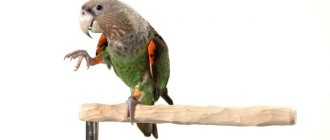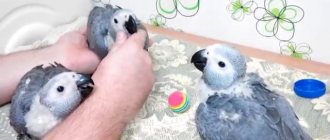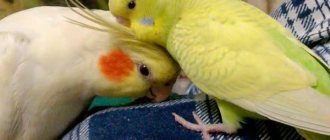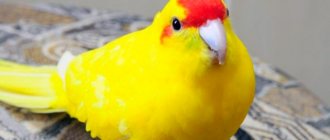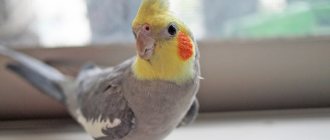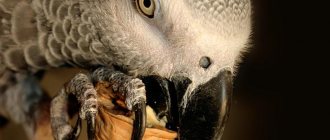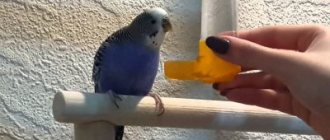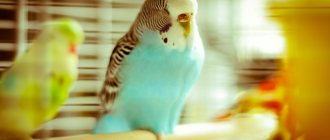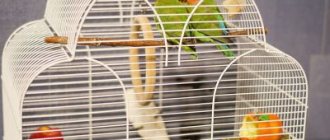In their natural habitat, all birds are constantly exposed to the open sky and sunlight.
But when they get into a closed box of some high-rise building, the same parrots experience an acute lack of solar radiation.
All rays that penetrate through the glass of plastic windows lose most of the necessary ultraviolet component. Namely, UV radiation is primarily required for the full growth and development of feathered creatures.
Therefore, your primary task is to find and hang in the room a light source that can replace the natural sun as much as possible. A regular incandescent light bulb is not enough here.
A lamp for birds must contain “soft” and “medium” ultraviolet rays in its spectrum.
Why do birds need ultraviolet light?
Before selecting specific models, let's find out what is so useful in UV rays?
The first benefit of UV radiation
Vitamin D3
Vitamin D is necessary for both birds and people to fully absorb calcium and is produced in the body after ultraviolet radiation penetrates the skin.
The formation of the bird’s skeleton and its plumage directly depends on it. Artificial supplements and vitamins cannot fully replace the effect of “real” ultraviolet radiation.
Without enough calcium, especially in the early years, parrots develop beak and claw problems.
Second benefit
Vision
In birds it is much sharper than in humans.
Our retina is sensitive to three primary colors (blue-green-red). Which sometimes leads to very non-trivial situations.
But parrots are also able to distinguish ultraviolet light. Just like the artist Claude Monet.
Under normal lighting from an incandescent lamp, parrots see a picture around them that is distorted in color. And only in the presence of a UV component do they acquire the ability to clearly distinguish each other’s colored plumage.
Thus, determining the opposite sex of their relative.
In addition, fruits, plants and berries also acquire their natural shades, which makes them more appetizing in the eyes of birds.
In the natural environment, they determine in a similar way whether a given fruit can be eaten or not (whether it is ripe or green). Mold is especially visible in ultraviolet light.
A bird, seeing such a picture, will never eat such food. Under an ordinary light bulb, birds do not notice any of this.
Parrots raised at home without UV radiation will not even know whether the food you offer them is edible or not. Therefore, most often they will refuse it.
Hang a UV lamp and over time everything will change. They will happily begin to eat food that is new to them, which they previously rejected.
This is not due to their taste, but to the fact that previously they could not distinguish and see the color combinations that were familiar to them.
The third reason for the mandatory use of special lamps
Parrots have two sources of vision.
- eyes
- Harderian gland
The latter is closely related to the endocrine system of birds. It is by this that they sense the length of daylight hours.
If there is enough ultraviolet light, the bird’s body works like a clock:
- nesting
- masonry
- regular shedding
Everything is on your own schedule. As soon as the UV abyss occurs, the endocrine system becomes imbalanced.
From all of the above, it becomes clear that it is impossible to do without a special lamp for birds constantly kept in enclosed spaces.
Briefly about ultraviolet rays
To understand the importance of ultraviolet light reaching parrots, you should take a closer look at the facts about ultraviolet radiation.
It can come from both sunlight and artificial sources.
And the light itself is divided into three types of range:
- from 400 to 320 nm is UV-A;
- from 320 to 275 nm is UV-B;
- from 275 to 180 nm is UV-C.
Separately, each range of light assumes its own level of permeability into a living organism, as well as a biological effect on it.
The first type of range, for example, is not able to linger in the ozone layer, penetrating in full through glass.
In turn, almost all of the UV-B is retained in the ozone layer, without penetrating through the glass, delivering only 3% of ultraviolet radiation at solar noon.
The third type of range guarantees penetration into the epidermis only through direct contact with a living organism, but it does not pass beyond the skin, and is also completely blocked by the glass coating.
If ultraviolet radiation has a wavelength from 280 to 313 nm, the human body, under its influence, is able to produce fat-soluble vitamin D, without which calcium absorption is almost impossible.
If the waves are less than 270 nm, ultraviolet radiation, on the contrary, destroys vitamin D, so special filters are provided in artificial ultraviolet suppliers.
For reference! Glass is the main cause of sun starvation in birds, which leads to fatigue and lethargy, irritability and other negative consequences.
It is also worth recalling that sunlight is the best bactericidal protector of the body, which helps destroy infections, bacteria and pathogens.
But only if there is a rational supply of ultraviolet radiation can it be useful to living organisms.
How to choose a bird lamp
By what characteristics should it be selected?
To choose the right lamp for a budgie or other bird, you need to pay attention to three technical parameters.
Parameter No. 1
Color coefficient or color rendering index
It has several abbreviated names: CRI or Ra.
This coefficient for bird lamps should be equal to or exceed 90.
Sometimes instead of Ra=90 they write 1A on the packaging. This means almost the same Ra=90-100.
Indicator 1B corresponds to Ra=80-89.
Parameter No. 2
Colorful temperature
It is measured in Kelvin and is designated by the capital letter K. Bird bulbs should have a color temperature in the range of 5000-6000K.
If you find models from 5300 to 5500, then this will be an ideal option.
As experts say, if this indicator exceeds 5800K, then the clutches of birds will predominantly produce females.
Parameter No. 3
Ultraviolet
All ultraviolet light is divided into three components:
- UV-A
- UV-B
- UV-C
Lamps containing the following ultraviolet ray content are ideal for parrots:
- UV-A or UV-A=12%
- UV-B or UV-B=2.4%
UV-A is soft ultraviolet light, often emitted even by ordinary lamps. However, the main component here is the mid-spectrum UV-B.
In those concentrations that are used in light bulbs for birds, it is absolutely safe for humans.
But neither a parrot nor a person should be irradiated with hard or medium UV in superdoses. Lamps used in solariums, for medical purposes, or for drying manicure polish should never be used on birds.
Lamps for reptiles and aquariums are also not suitable.
Please note that all UV light sources have their own service life. With daily use, a good lamp becomes unusable after about a year.
Of course, it won’t stop shining, but your parrot won’t get any useful ultraviolet light from it. The intensity of UV rays decreases over time in all models.
And this is not about the manufacturer or the quality of the product. This is a natural process.
Some lamps last longer, others less. Conventional housekeepers with an E27 base are more convenient for home use.
They can be screwed into any home lamp or table lamp on a clothespin.
Lamp selection
Advertising is an active engine of trade, so you can find a huge number of different promises on packaging, and advertising may not contain the most honest information. It is better to study all the intricacies yourself and then go to the nearest pet store to purchase. It is necessary to know the disadvantages and advantages of different types of arcadia llamas.
Ultraviolet
A UV lamp for a parrot is the most ideal option. Thanks to its use, pets produce a sufficient amount of vitamin D. Their advantages also include the following:
- More light output with the same power.
- Long operating time.
- The properties of the generated light are as similar as possible to real light.
Arcadia lamps
The best lighting device for a feathered pet is the Arcadia bird lamp. Its advantages include the fact that the most suitable range of ultraviolet radiation is used (most similar to natural sunlight), and a good heat transfer coefficient.
Research also confirms that the use of arcadia lamps has a positive effect on the reproduction of birds due to the fact that their color looks more advantageous in the eyes of the opposite sex.
Salt
The peculiarity is that the lampshade is made of real salt, mined in ecologically clean areas. It is unknown how effective its use is for parrots. A heated salt lamp can emit a large amount of fumes, which birds feel especially acutely.
Blue
Lighting devices that operated by heating were very popular several years ago. Most often it was used to treat various types of inflammation. Nowadays it is actively used by those who like to grow plants at home as an “Artificial Sun”.
Incandescent lamps
The most popular light source, the power of which is 60 W, they get very hot and glow yellow. LN is only suitable for heating a parrot. If you carefully monitor your pet, you can see that he is freezing.
In this case, you can hang the LN at a distance of half a meter from the cage, thereby warming the bird.
LED
The most popular color source at the moment. In addition to performing direct tasks, it allows the owner to save money on paying electricity bills. Thanks to the research, it was concluded that the light from LED lamps is beneficial for the human body, but undesirable for parrots.
UV fluorescent tubes
If you are looking towards a fluorescent tube, be sure to pay attention to such parameters as flickering and pulsation.
For our vision, even large pulsations are elusive, but birds can clearly distinguish them, begin to behave very nervously and react sharply to such light.
Therefore, check the ripples even when purchasing in a store, at least with an ordinary smartphone.
Also on the packaging of LB tubes, look at the product markings. They can have the following values - 950, 940, 930, etc.
The first number “9” indicates that the lamp has a CRI>90. Just what we need.
If there is an eight (8), then the color coefficient is Ra=80-89.
The next number indicates the color temperature.
- 50 – 5000K
- 40 – 4000K, etc.
As you understand, among fluorescent tubes it is best to buy models with a value of 950. The highest quality lamps for birds are produced by Phillips, Arcadia, Osram.
They are called Bird Lamp.
For each fluorescent tube you will have to buy an LPO type lamp with built-in electronic ballasts.
Recommendations
Experienced breeders recommend visiting several thematic forums first and seeing what lighting devices the majority of owners use. It would be a good idea to carefully inspect the box at a pet store or electrical shop and look for the inscription “for birds.”
If it is missing, compare the data on the packaging with those recommended for birds.
Glow time
How long should such a light stay on? It should be turned on all daylight hours:
- 10-12 hours in winter
- 12-14 hours in summer
Ideally, the duration should be set using a solar calculator. Lights turn on 1 hour after sunrise, turn off 1 hour before sunset. Similar to when a bird is in the wild.
This schedule can be configured using timer sockets.
This is why we buy such things, to create living conditions for birds as close to natural as possible. But shining longer than daylight hours is very dangerous.
This way you will break the breeding cycle of the bird.
The importance of lighting for parrots
Many parrot breeders think that the bird's cage must be placed in a bright room with sufficient sunlight. This way the parrot will receive the necessary light and will be saturated with ultraviolet radiation, and the installation of additional lighting devices will not be required.
But this is a misconception, because there is a difference between the rays that come through the surface of the glass and those that illuminate the street. Through the thickness of the glass, a low level of ultraviolet radiation enters, which may not be enough for the body of a feathered pet.
To meet the needs of ultraviolet radiation, a lamp for parrots is suitable. It will be able to provide a sufficient set during the day and evening, especially in winter and autumn. But the owner must be prepared for the fact that increasing the duration of light may encourage the feathered pet to reproduce.
Installation height
At what distance from a parrot should a light bulb be hung? The power of such UV lamps is usually low, and besides, they do not produce a beam, but scatter the rays.
Therefore, the lamp must be installed directly above the place where the bird most often visits - a cage or a play stand.
The height of the suspension is no more than 0.5 meters to the perch on which it sits.
It is important to understand here that the further it is from the bird, the less necessary ultraviolet radiation the feathered creature will receive. When using the “correct” light bulbs, it is impossible to achieve an overdose.
First of all, make sure that your parrot does not accidentally break or destroy this light source. Therefore, it is impossible to bring the lamp too close precisely for this reason.
Even when hanging a light bulb above the cage, do it in such a way that the birds still have the opportunity to go a little into the shadow from its direct rays.
Some choose LB tubes that are cage length or even longer. It's better not to do this.
Lighting schedule
In order for the light from the lamps to replenish the bird’s body with the required substances and improve its health, it is important not only to choose the right device, but also to know the schedule for turning on the lighting. To make this task easier, you will need a special timer that will help regulate the length of daylight hours for the parrot and not waste electricity for nothing.
The timer will be especially convenient in cases where you often have to go on business trips, if you are planning a departure, and the bird will be alone in the room for a long time. This device will allow you to set the correct lighting schedule for parrots, which will correspond to the biorhythms and mode of the bird.
Mesh and diffuser
Is it necessary to purchase additional equipment in addition to the lamps themselves? For example, things like a diffuser or protective metal mesh?
If your bird is not locked in a cage and has free access to the lamp, then protection in the form of a mesh is required. The parrot will definitely show curiosity and one day make an attempt on the light bulb.
You can make the mesh either with your own hands or purchase a factory product.
But diffusers are not required in principle. They will simply absorb part of the useful radiation for which you bought this light source.
Replacing ultraviolet
Many people mistakenly think that if you place a cage with a parrot near a window, then a UV lamp is not needed at all. This is wrong.
It is not possible to completely replace ultraviolet light in this way. Firstly, UV rays are partially blocked by glass.
Secondly, the sun never shines directly into your window for 10-12 hours. No matter which side of the house the room was on.
Moreover, UV lamps themselves do not guarantee full receipt of the necessary microelements from this type of rays. Birds, like other animals, must be taken outside into natural sunlight from time to time.
What should be the requirements for lamps?
The color temperature of sunlight is 5500 K; an artificial light source has the most similar indicators. The temperature coefficient should be in the range of 5000 to 5500 K, if the value is higher, the parrot may damage the eyesight.
You need to change the lamp once a year, you can simplify the process - after about six months, buy a second one, and change one lamp every six months. Most manufacturers put a special mark “for birds” on their products. This guarantees the harmlessness of using the device for its intended purpose.
